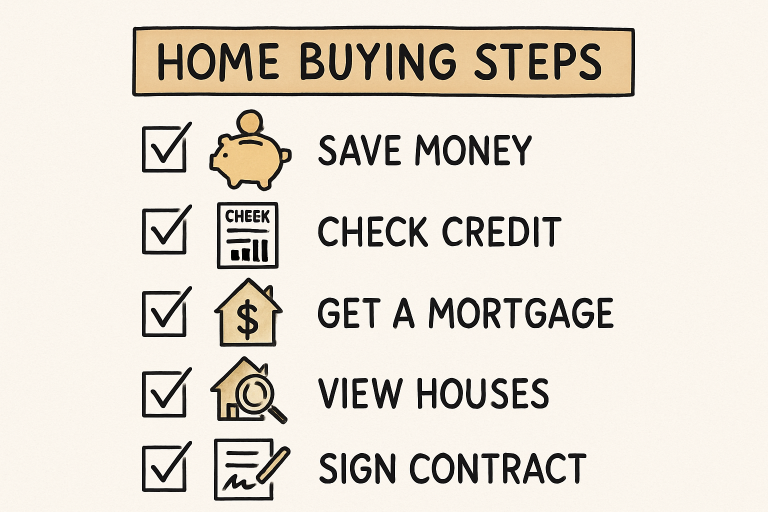Key Takeaways
- Assess your finances and credit before starting the home-buying process.
- Save for both down payment and closing costs to avoid last-minute surprises.
- Mortgage pre-approval significantly strengthens your offer to sellers.
- Partner with a trusted real estate agent who knows your market.
- Take your time house hunting and carefully evaluate each property.
- Thorough inspections and appraisals are essential steps before closing.
Table of Contents
- Assess Your Financial Health
- Save for a Down Payment and Closing Costs
- Get Pre-Approved for a Mortgage
- Define Your Home Preferences
- Hire a Real Estate Agent
- Start House Hunting
- Make an Offer and Negotiate
- Conduct a Home Inspection and Appraisal
- Close the Deal
Assess Your Financial Health
The foundation of buying a home in 2025 starts with a candid assessment of your financial status. Start by reviewing your credit report and score, as these will significantly influence your mortgage options and interest rates. Higher scores can mean lower rates, while poor credit can limit your choices or result in higher costs.
Next, calculate your monthly income, debts, and regular expenses to determine exactly how much house you can afford. Lenders will look at your debt-to-income (DTI) ratio when deciding your loan eligibility. For homes in popular California destinations, like Healdsburg, CA, homes for sale, a stable financial footing can make a big difference in your buying experience. It’s also smart to set aside extra funds for unexpected costs, such as home repairs or moving expenses. Careful planning ensures your home purchase remains manageable and stress-free.
Save for a Down Payment and Closing Costs
Traditional advice suggests putting 20% down, but some loans require as little as 3%–5%. However, by increasing your down payment, you can reduce your monthly payments and avoid paying for private mortgage insurance (PMI), which protects lenders if you default. Besides the down payment, don’t forget to budget for closing costs—these can add 2%–5% of the purchase price to your upfront expenses.
Besides these significant upfront costs, keep reserves for moving expenses, immediate repairs, and new furnishings. Saving strategically helps ensure you’re ready for all the financial surprises that come with homeownership.
Get Pre-Approved for a Mortgage
Securing a mortgage pre-approval not only streamlines your search but also signals to sellers that you’re a serious buyer. A lender reviews your financial documents to confirm your eligibility and set a borrowing limit. This allows you to shop for homes within your means and can give you an advantage in competitive markets, where sellers are more likely to accept offers from pre-approved buyers.
The pre-approval process can also uncover any errors or financial red flags early, giving you time to address them before you find your dream home.
Define Your Home Preferences
Start your home search by outlining exactly what you need and want. Consider the ideal number of bedrooms and bathrooms, as well as location priorities such as proximity to work or schools, and desired community amenities. Create a list separating must-have features (such as a minimum number of bedrooms, safety, or a backyard) from nice-to-have ones (like a renovated kitchen or a pool).
Having a firm set of criteria not only focuses your search but also helps your real estate agent identify suitable properties faster. The real estate market, particularly in desirable areas like California wine country, can move quickly, so clarity is key.
Hire a Real Estate Agent
A reputable real estate agent serves as your advocate throughout the buying process. They can access listings faster than public portals, arrange showings, provide market context, and negotiate on your behalf. To understand more about the role and benefits of a real estate agent, you can refer to this detailed guide by Investopedia. Choose an agent who is knowledgeable about your preferred neighborhoods, responsive, and attuned to your communication style.
Start House Hunting
With your criteria in hand and your agent’s help, begin scheduling home tours. Take detailed notes and photos during each visit to compare options more effectively later. This step may take time—be patient and resist pressure to make hasty decisions. Explore neighborhoods at different times of day for a complete picture of what life there will be like.
Make an Offer and Negotiate
Once you find the right home, your agent will help you draft a competitive offer based on comparable sales, market conditions, and your budget. Expect negotiations—sellers may counter with a higher price or request different terms. Stay flexible, but know your upper limit when finalizing the deal. Ensuring a strong offer could include pre-approval letters and a flexible closing schedule.
Conduct a Home Inspection and Appraisal
After your offer is accepted, schedule a thorough home inspection to detect any underlying issues—everything from roofing and plumbing to electrical systems and the foundation. If significant problems are found, you may be able to negotiate repairs or credits with the seller. An appraisal is also conducted to confirm the home’s market value for your lender. If the property appraises below the agreed price, you may need to renegotiate. Learn more about why these steps are vital on Bankrate. Taking these precautions helps protect your investment and can prevent unexpected costs, making the entire process smoother and less stressful.
Close the Deal
Upon clearing any final contingencies, you’ll move forward to closing. This meeting involves signing all necessary documents, paying closing costs, and taking ownership. Once the deal is done, you’ll receive your keys and can move into your new home.
Patience, preparation, and the right team of professionals are keys to a smooth home-buying experience. By following these steps and doing your research, you increase your chances of landing a home you’ll love for years to come.


